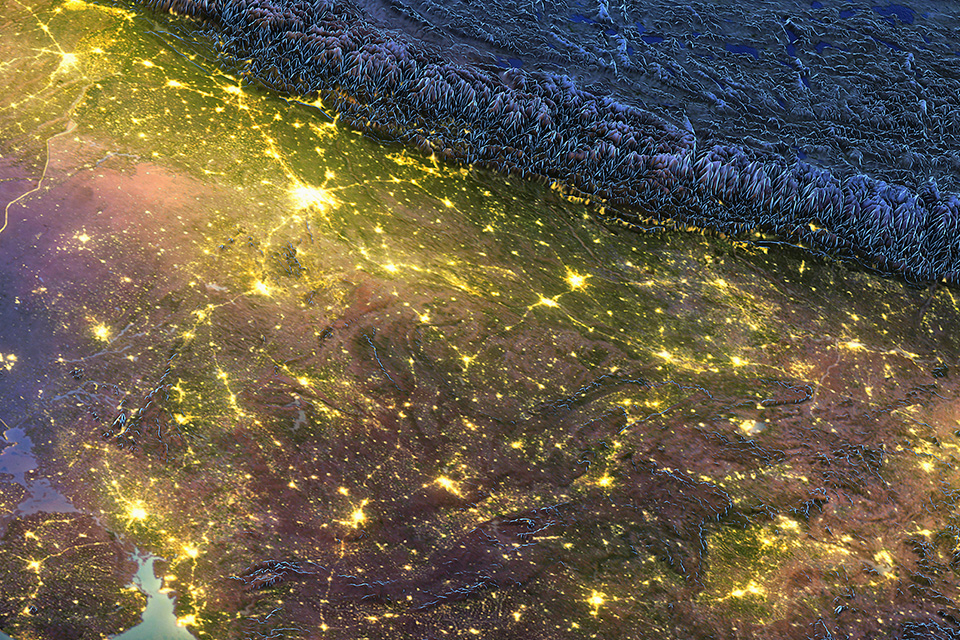The pandemic prompted a workplace shakeup, shining a spotlight on employee wellness
Amy Blankson offers tools that can boost happiness as we enter a new world of work


Hugh Verrier
Chair
In 2022 uncertainty took hold as inflation, volatile markets and a geopolitical conflict added to the challenges set in motion by the COVID-19 pandemic. In a world of shifting expectations and norms, we focused on creating a distinctive experience for our clients, consistent with the five-year strategy we launched in 2020. This North Star guided our global teams as they developed and executed innovative solutions on high-stakes deals, disputes and pro bono matters.
Our client work placed us at the center of global trends related to energy transition, environmental, social and governance (ESG) issues, finance and globalization. We contributed to the dialogue on these issues with published insights including “Scaling up the energy transition,” a report based on a survey that explores how capital providers and companies are setting priorities, staying competitive and managing risk. Through our COP27 video series, we explored themes raised during the annual climate conference and their potential impact on business and industry.
In regions around the world, we increased our capacity to serve clients, promoting 59 new partners and welcoming 39 lateral partners. We developed new ways of working with clients, increasing efficiencies and ensuring consistency. These initiatives included our Debt Finance Solutions Team, which leverages legal technology and other resources to handle certain types of routine work, and our Client Experience Blueprints, a series of tools that codify our global best practices for working with clients before, during and after a matter.
We continued to focus on building a more diverse and inclusive workplace, significantly expanding our diversity data collection efforts so we can quantify our progress. Our people benefited from new and expanded coaching programs, and we took concrete steps to empower our associates, focusing on work allocation, skills development and leadership opportunities.
This review discusses these and other accomplishments and initiatives that made a difference to our people and our clients in 2022. Together we face the future positioned for success.
Guest speakers at Firm events share views on timely topics
Amy Blankson offers tools that can boost happiness as we enter a new world of work

Kenneth Cukier talks about the process that can lead to breakthroughs and help us tackle novel challenges

Antonio Zappulla talks about how TrustLaw tackles some of the world’s biggest challenges

Developments that reshaped the world
The focus on achieving net-zero emissions by 2050 remained a priority for governments, investors and energy companies

Addressing ESG factors became “the new normal” for investors and businesses

Activity across debt and M&A markets slowed as rising interest rates and high inflation saw investors, borrowers and lenders recalibrate risk appetite

Around the world, legal and regulatory developments continued to reshape global interconnectedness

Highlights of our work in 2022
Our achievements position us for success
US$2.83 billion in revenue
2,616 total lawyers
Meet the outstanding generation of talented lawyers who strengthened our Firm in 2022

In markets around the world, White & Case earned many of the legal industry’s top accolades

White & Case is committed to fair and ethical operations that respect human rights and recognize the importance of our natural environment.
As a signatory to the UN Global Compact, we affirm our commitment to doing business responsibly by supporting the Compact’s ten principles on human rights, labor, the environment and anti-corruption. The steps we are taking to continue to embed these principles into our Firm are outlined in our most recent Communication on Progress.
Our latest Environmental Sustainability Report includes information on our environmental policies, footprint, key actions and goals.
Committed to advancing diversity and inclusion across the Firm
11 global affinity networks
Our 11 affinity networks foster a sense of community among the Firm’s Black, Asian, Latinx/Hispanic, Middle Eastern, minority ethnic and LGBTQ+ lawyers, business services professionals and their allies. Each network sets its own agenda, initiatives and goals, which are specific to the issues it considers most important. Affinity networks create and enhance awareness of these groups within the Firm and its larger culture, drive community and connection across our global offices, and support their members with career and professional development opportunities.
25 local women’s networks
Our 25 local women’s networks are active in 40 offices across the Americas, EMEA and Asia-Pacific. These networks foster professional development and mentoring activities. They also provide a forum for our lawyers and business services professionals to share perspectives and create programs to support and retain our women while fostering and promoting gender equity.
49%of our lawyers self-identify as of color
28%of our partners self-identify as of color
43%of our lawyers self-identify as of color
27%of our partners self-identify as of color
118nationalities
95languages spoken
Leading publications and alliance organizations continue to recognize our commitment to diversity and inclusion

Helping our colleagues to reach new heights
Committing to growth opportunities for colleagues in wide-ranging roles

Recognizing the value of our lawyers as they start their careers

Focusing on consistent application of best practices

Leveraging technology to streamline routine work and enhance client service

Collaborating to effect change and build strong connections

Visuals by Roman De Giuli

The global focus on achieving net-zero emissions by 2050 remained a priority for governments, investors and energy companies in 2022, despite escalating geopolitical tension and energy market dislocation. In particular, Russia’s invasion of Ukraine and the subsequent energy price and supply chain shocks led to lawmakers reappraising energy transition timetables. In addition to navigating through this volatile landscape, governments and investors contended with the ongoing complexities of understanding new energy technologies and developing structures for unlocking the substantial sums of capital required to fund the shift to cleaner energy sources.
White & Case supported a wide range of companies, investors and financiers on their energy transition journeys through these tumultuous 12 months. Here are some of the key themes we focused on in 2022.
Repurposing the global energy mix to deliver net-zero emissions by 2050 will require clean energy investment to more than triple by the end of the decade to around US$4 trillion. Despite a wider market slowdown and energy market dislocation during the year, there were positive signs of investors rising to the net-zero emissions challenge. Global investment in renewables increased by 11 percent year-on-year over the first half of 2022 to reach a record high of US$226 billion, while decarbonization served as a major spur for M&A.
In Europe, infrastructure funds expanded their exposure to green energy with investments in solar, biomass, wind and waste-to-energy assets. In New Zealand and Australia, infrastructure funds were similarly active in wind power deals. In Japan, meanwhile, energy and utility M&A volumes had matched previous annual records by May 2022, with the country’s wind and solar sectors attracting substantial investment from local and foreign buyers.
This investment pace will have to be sustained to meet emissions reduction goals, and 42 percent of the energy companies polled in a White & Case survey indicated that capital investment in energy transition was a high priority, more than triple the level of 14 percent recorded two years ago.
Survey participants also signaled expectations to draw from a widening palette of capital sources to finance their transitions, ranging from their own balance sheets to third-party capital from private equity, export credit agencies, debt and equity markets and banks.
Short-term energy market disruption will pose challenges for energy transition financing, but the long-term outlook for investment remains broadly positive.
Reaching net-zero emissions by 2050 will involve developing a broad spectrum of renewables and low carbon technologies.
Solar and wind power generators are now of sufficient scale and maturity to compete with hydrocarbon generated energy and have been able to attract third-party financing on competitive commercial terms as a result. Abu Dhabi solar power operator Sweihan PV Power Company, for example, secured a landmark US$700.8 million green bond, the first issued in the Middle East, to refinance its Noor solar photovoltaic power generation plant, the largest single-site solar project in the world.
Expanding renewables provision beyond mature markets such as wind and solar, however, represents the next step on the pathway to achieving net zero. Batteries and geothermal power are among the energy sources that will have to develop to fill in supply as hydrocarbons are phased out. Investors and companies are actively seeking to maximize opportunities in these areas.
China’s electric vehicle (EV) battery industry, for example, has remained active despite domestic economic headwinds. Chinese miners extracting materials required for battery manufacturing have invested in mining companies and won concessions across Latin America and Africa, consolidating their market-leading position in the EV battery supply chain. Chinese battery makers, meanwhile, have invested in building production facilities closer to key markets and customers in the United States and Europe, while also broadening out into other adjacent areas, including battery recycling and battery manufacturing for applications other than EVs.
Investment momentum behind geothermal energy—which produces heat from the earth’s surface—is also building, with governments providing financial and legislative support to boost development. The Indonesian government has put a program in place to underwrite geothermal site exploration and mitigate investor risk by selling proven fields to investors, while in the Philippines domestic ownership requirements for large-scale projects have been waived in the geothermal space to bring in investment from foreign developers.
The fact that geothermal energy is less vulnerable to supply intermittency—which impacts solar and wind farm energy production and takes up less than one fifth of the space required by a solar farm to generate one gigawatt per hour (1 GWh) of electricity—is likely to advance the still nascent geothermal market to grow into an increasingly important contributor to the low carbon energy mix.
Investment in a growing array of renewable energy technologies may be accelerating, but oil & gas will still play a key role in keeping economies running as the long-term transition to low emissions energy takes place. In some cases, hydrocarbons will be required to power the manufacturing, construction and onboarding of renewable energy infrastructure.
Divesting altogether from traditional, high-emission energy production could, therefore, prove counterproductive to net-zero goals. Engagement with high-emission energy producers, along with support for carbon capture and carbon reduction implementation, may yield better outcomes.
Close to half of the investors surveyed by White & Case agreed that they preferred to engage with emissions-intensive portfolio companies to lower emissions rather than divest, with 42 percent agreeing that divestment from energy-intensive businesses was a last resort.
In the developing world carbon capture is an important bridge to lowering long-term emissions as hydrocarbons will remain the cheapest and most accessible form of energy provision in emerging economies. In mature economies emissions reduction will also be important, especially given the recent increase in fossil fuel consumption in response to near-term threats to energy security.
The risk of climate litigation has continued to intensify during the last 12 months, with the pool of possible claimants and defendants expanding as new areas of litigation related to climate change emerge.
Claims related to climate change traditionally sought damages from the so-called oil majors, as the producers and distributors of hydrocarbons, but had limited success given the complexity of energy supply chains and the difficulties of linking alleged harm to a specific entity’s emissions. Claimants, however, have moved to expand the scope for litigation by making claims for relief other than damages.
These rights-based claims do not require evidence to prove causation between a defendant’s emissions and the alleged climate-linked harm. Instead, claimants invoke their human rights to hold defendants accountable for climate change commitments. These claims once predominantly targeted governments, but more recently have also been brought against companies, with the potential to expand climate change liability and impose restrictions on the manufacturing of products with high emissions.
Photo by Richard Hamilton Smith © Getty Images
Aerial view of wind turbine blades